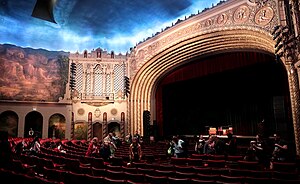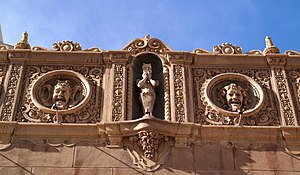| This article needs additional citations for verification. Please help improve this article by adding citations to reliable sources. Unsourced material may be challenged and removed. Find sources: "Orpheum Theatre" Phoenix, Arizona – news · newspapers · books · scholar · JSTOR (August 2018) (Learn how and when to remove this message) |
 | |
| Former names | The Paramount, Palace West |
|---|---|
| Address | 203 W. Adams St. Phoenix, Arizona United States |
| Owner | Phoenix Convention Center & Venues |
| Operator | Phoenix Convention Center & Venues |
| Type | Touring Theater |
| Capacity | 1,364 |
| Construction | |
| Opened | 1929 |
| Closed | 1984 |
| Reopened | 1997 |
| Architect | Lescher & Mahoney, Hugh Gilbert |
| General contractor | McGinty Construction Company |
| Tenants | |
| American Theatre Guild Phoenix Opera | |
| Website | |
| www | |
| Orpheum Theater Phoenix | |
| U.S. National Register of Historic Places | |
  | |
| Coordinates | 33°26′56.73″N 112°4′33.3″W / 33.4490917°N 112.075917°W / 33.4490917; -112.075917 |
| Architect | Lescher & Mahoney; Gilbert, Hugh |
| Architectural style | Spanish Revival/Baroque Revival |
| MPS | Phoenix Commercial MRA |
| NRHP reference No. | 85002067 |
| Added to NRHP | September 4, 1985 |
The Orpheum Theatre is a 1364-seat theatre in downtown Phoenix. This venue was originally used for vaudeville acts as part of the nationwide Orpheum Circuit.
History
Construction began in 1927 and was completed in 1929 for a total cost of $750,000. It was designed by architects Lescher & Mahoney, with Hugh Gilbert associated. It was built for owner-operators J.E. Rickards and Harry Nace by the McGinty Construction Company. Built in a Spanish Revival style of Spanish Baroque architecture style, intricate murals and moldings were an integral part of the design, all meant to give patrons the impression that they were enjoying the shows "al fresco."
In the 1940s the Orpheum was purchased by the Paramount Pictures chain, and renamed, "The Paramount." In the 1960s Nederlander purchased it to add it as a stop on the Broadway circuit. Throughout the 1960s until its restoration, it was renamed, "Palace West."
Throughout the mid 1970s and early 1980s, the Theatre was leased to the local Mexican enterprising Corona family, who presented a wide variety of Hispanic events and movies. At one point all the murals and moldings were painted black when the Orpheum was used to show Spanish films. In addition to wanting to hide the areas that were already in poor condition, it was thought that such decorations would detract from the films.
- Restoration
After falling into disrepair for some years, the city of Phoenix purchased the Orpheum Theatre in 1984 and began a 12-year, $14 million restoration. The Conrad Schmitt Studios created the transformation and the Orpheum reopened on January 28, 1997, with a performance of Hello, Dolly! starring Carol Channing. After the performance, Ms. Channing, still in costume but out of character, thanked the audience for "not turning this beautiful theatre into a parking lot!"
Present day
The Orpheum Theatre of Phoenix was placed on the National Register of Historic Places in 1985.
In 1997, the Orpheum became home of the newly-formed Phoenix Opera.
In addition to the Phoenix Opera, the Orpheum presents concerts, Broadway musicals, performances of Ballet Arizona and special events.
In 2019, Arizona rock band The Maine released a live album that was recorded at the Orpheum Theatre.
See also
References
- "National Register Information System". National Register of Historic Places. National Park Service. January 23, 2007.
- "Arizona Republic 05 Jan 1929, page Page 18". Newspapers.com. Retrieved 2022-08-24.
- "Beginnings and Restoration". Friends of the Orpheum Theatre. Retrieved August 21, 2018.
- "Orpheum Theatre: Phoenix, Arizona". Conrad Schmitt Studios. Retrieved August 21, 2018.
- ^ "Phoenix's Historic Orpheum Theatre Reopend (sic) 20 Years Ago after Massive Restoration" (Press release). City of Phoenix. January 27, 2017. Retrieved August 21, 2018.
- Schweitzer, Vivien (May 17, 2007). "Former Met Star Founds Opera Company in Phoenix". Playbill. Retrieved August 21, 2018.
External links
| Music venues of Arizona | |
|---|---|
| Outdoor venues | |
| Theaters and clubs |
|
| Arenas | |
| Historic venues |
|
| Properties on the National Register of Historic Places in Arizona | |||
|---|---|---|---|
 |  | ||
| Municipalities and communities of Maricopa County, Arizona, United States | ||
|---|---|---|
| County seat: Phoenix | ||
| Cities |  | |
| Towns | ||
| CDPs | ||
| Populated places |
| |
| Indian reservations | ||
| Ghost towns/ former populated places | ||
| Footnotes | ‡This populated place also has portions in an adjacent county or counties | |
- Cinemas and movie theaters in Arizona
- Music venues in Arizona
- Buildings and structures in Phoenix, Arizona
- Culture of Phoenix, Arizona
- Phoenix Points of Pride
- Theatres completed in 1929
- National Register of Historic Places in Phoenix, Arizona
- Theatres on the National Register of Historic Places in Arizona
- Event venues established in 1929
- Tourist attractions in Phoenix, Arizona
- Spanish Revival architecture in the United States
- 1929 establishments in Arizona
- Theatre in Arizona
- Theatres in Arizona


